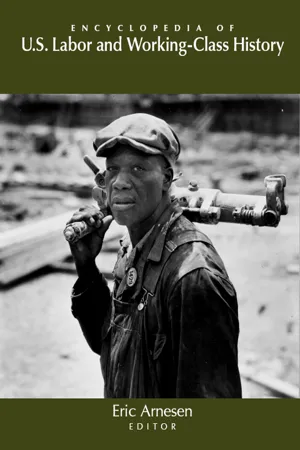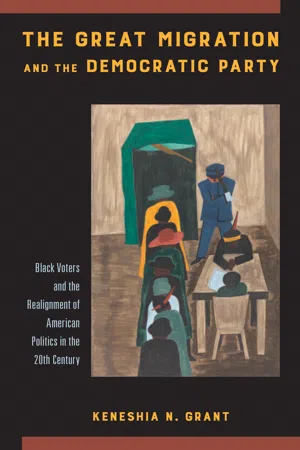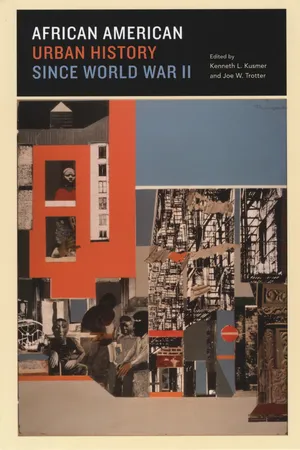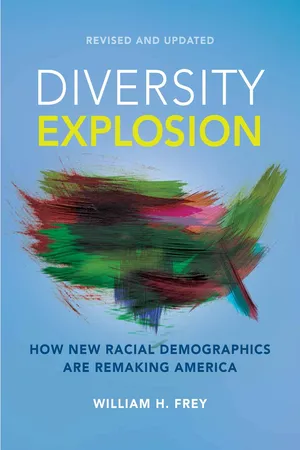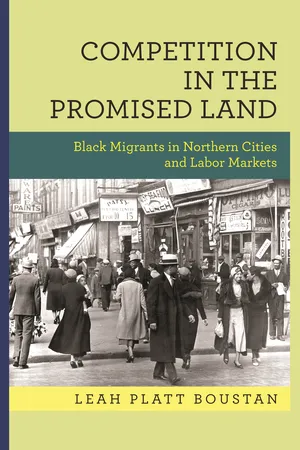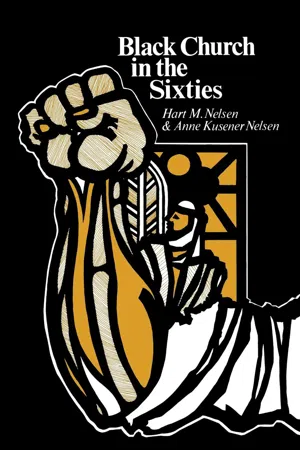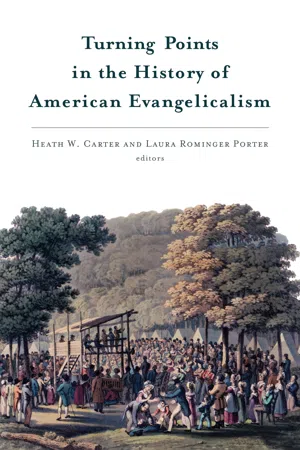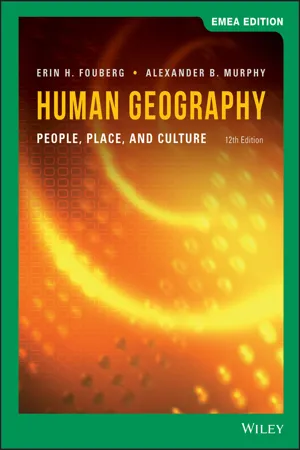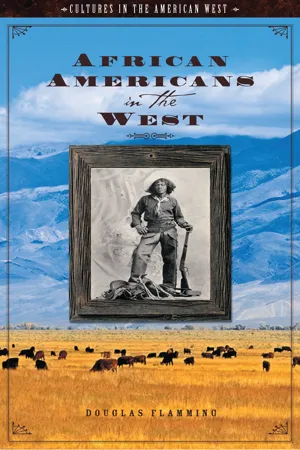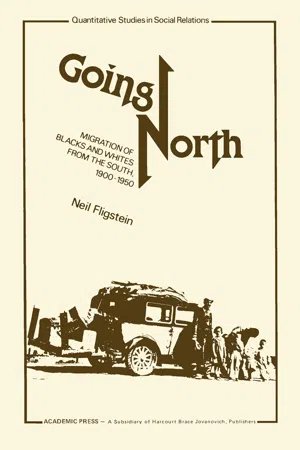History
Great Migration
The Great Migration refers to the mass movement of African Americans from the rural South to the urban North of the United States between 1916 and 1970. This migration was driven by factors such as economic opportunities, escape from racial segregation and violence, and the search for a better quality of life. It had a profound impact on the demographics, culture, and politics of the United States.
Written by Perlego with AI-assistance
Related key terms
1 of 5
12 Key excerpts on "Great Migration"
- Eric Arnesen(Author)
- 2006(Publication Date)
- Routledge(Publisher)
Great Migration The Great Migration of the World War I era witnessed the geographical relocation of 450,000 to 500,000 African-Americans from the states of the South to industrial cities in the North; during the 1920s, another wave of migration brought an additional 700,000 black southerners to northern cities. While African-Americans had never been stationary, the scale of the Great Migration was unprecedented. As such it was accompanied by considerable public scrutiny and at times, social conflict. African-Americans, like their white counterparts, discussed and debated the causes, character, and impact of the movement of so many people; unlike their white counterparts, they tended to understand and even celebrate the movement as a decisive move toward a better life despite the obstacles to advancement that blacks encountered in the North. If the movement of southern blacks “came as a surprise, to North and South alike,” as the white periodical, the Contemporary Review, put it in 1918, “its causes were of long standing.” African-Americans’ reasons for migrating were straightforward. So-called “push factors” prompting the decision to leave the South included grinding poverty, wide-spread antiblack violence, the denial of political rights (capped by a wave of disfranchisement laws and constitutional provisions), the lack of educational and other opportunities, and the day-to-day humiliations that the system of white supremacy and Jim Crow imposed on black southerners. As largely rural sharecroppers, southern blacks were often mired in debt and poverty, exercising little control or influence in the economic realm. The outbreak of World War I in 1914 cut off the European market for southern cotton exports, contributing to an agricultural depression, while flooding and a growing boll weevil infestation of southern cotton crops initially hurt southern farmers and sharecroppers- eBook - PDF
We Ain’t What We Ought To Be
The Black Freedom Struggle from Emancipation to Obama
- Stephen Tuck(Author)
- 2011(Publication Date)
- Belknap Press(Publisher)
During a massive re-location that would become known as the Great Migration, some 1.5 million African Americans left the rural South, so that by 1920 one third of African Americans lived in cities. Most moved to southern cities, but nearly half a million left the South altogether. There were many reasons why people moved. Some left the rural South to flee violence. Others left because the price of cotton collapsed from 1913 to 1915, and the boll weevil wreaked devastation soon after. Many headed north dreaming of freedom. Most joined family members who had already moved. The Chi-cago Defender claimed some of the credit, having launched a “great northern drive” in May 1917. With the help of black railroad porters, the Defender reached parts of the South that other newspapers couldn’t reach. Headlines like “Flight Out of Egypt” invested black migration with divine approval. Yet black southerners had been vulnerable and poor before the Great Migration, and this was not the first time they had been urged to head north. Many elite black southerners, and a few thousand poorer African Americans, had already done so. What was new was that jobs had sud-denly become available in previously all-white northern industries. Euro-pean immigration plummeted because of the war, at just the moment that wartime production stretched American industry to its limit. The intro-duction of the military draft in 1917 shrank the labor pool still further. The primary cause of the Great Migration, then (given that there were few incentives to stay in the rural South), was the promise of a half-de-cent wage in the city. This was true for poor southerners regardless of color—indeed, more whites than blacks left the South. The Great Migration marked the beginning of some fifty years of black migration away from the rural South that would ultimately affect race re-lations in the United States as much as the Civil War or the Civil Rights Movement. - eBook - PDF
The Great Migration and the Democratic Party
Black Voters and the Realignment of American Politics in the 20th Century
- Keneshia N. Grant(Author)
- 2020(Publication Date)
- Temple University Press(Publisher)
These migrations were important to the spatial placement of Black people in America. By 1910, Black Americans lived in more places than ever. Although many faced resource challenges that contributed to their decisions to remain in the South, some left to try life in the North. But these early movements of Black Americans paled in comparison to what would occur later in the twentieth century. In the rest of this chapter, I describe the largest migration—the Great Migration—in terms of its causes, participants, and potential to influence American politics. The Great Migration Scholars debate the exact start and end of the Great Migration. However, most agree that migration occurred in two waves, as prompted by world wars and changes in the agricultural econo-my (Gregory 2006; Johnson and Campbell 1981; Scott 1920; Spear 1967). The first wave began around 1915, as northern industrial labor agents—who offered to pay moving expenses and help migrants find accommodations in the North—entered the state of Florida, looking for individuals who were willing to relocate to Pennsylvania for work (Johnson and Campbell 1981: 72; Scott 1920: 38). Once it became clear to Black southerners that oppor-tunities for work were available outside the South, they started moving on their own, and the use of labor agents decreased. In the late 1920s and early 1930s, the Great Depression slowed the migration to half its previous pace as opportunities for work disappeared (Trotter 1991: 10): Despite high unemployment, nearly 300,000 blacks moved out of the South during the 1930s, partly because new public assistance programs helped mitigate the im- Black Migration in American History / 45 pact of declining employment in the private sector. (Trot-ter 1991: 11) The number of people going north increased again after the start of America’s involvement in World War II. The second wave of the Great Migration began in the 1940s and lasted through the 1960s. - Kenneth L. Kusmer, Joe W. Trotter, Kenneth L. Kusmer, Joe W. Trotter(Authors)
- 2009(Publication Date)
- University of Chicago Press(Publisher)
The exodus began in the early part of the twentieth century, especially dur-ing World War I and the 1920 s, and that first phase has long been called the Great Migration. The label may have been premature. By some measures, a greater migration was still to come. Beginning during World War II and lasting through the Vietnam era, African Americans left home in unprec-edented numbers, and in doing so, they reshaped their own lives and much more. Close to five million people left the South between 1941 and the late “ 20 gregory 1970 s. More millions left farms and villages and moved into the South’s big cities. Within one generation, a people who had been mostly rural became mostly urban. A people mostly southern spread to all regions of the United States. A people mostly accustomed to poverty and equipped with farm skills now pushed their way into the core of the American economy. And other changes followed. A people who had lacked access to political rights and political influence now gained both. 2 This essay explores key dimensions of the Second Great Migration. Less is known about the second than about the first sequence of black migration from the South, and even the basic numbers appearing in encyclopedias and textbooks are often incorrect. New statistical data and new research by historians and sociologists enable us to clear up some of the confusion. Much of what I will report is based on the Integrated Public Use Microdata Series (IPUMS) that have been developed by the Minnesota Population Center in cooperation with the Census Bureau. 3 The pages that follow assess several issues: where people went and in what numbers; who moved and why; their impact on the cities they went to and on the South they left behind. And I also assess their experiences. Did most benefit from relocation? The Second Great Migration is usually defined as migration from the South to other regions of the country.- eBook - PDF
Diversity Explosion
How New Racial Demographics are Remaking America
- William H. Frey(Author)
- 2018(Publication Date)
- Brookings Institution Press(Publisher)
1900 0 20 40 60 80 100 regional migration—out of and now back to the South—and what it implies for the South and its states and metropolitan areas. Its counter-part migration, the black shift to the suburbs, is discussed in chapter 8. Southern Evacuation The South has always been the primary regional home for blacks. From the beginning of the nation until the start of the twentieth century, at least nine in ten blacks resided in the South, predominantly in rural areas. 24 Although the Thirteenth Amendment gave blacks new free-dom to migrate, farm tenancy arrangements, poverty, high levels of illiteracy, and the paucity of opportunities in the North kept black migration from the South at a modest level. 25 All of that changed early in the twentieth century. In the six decades between 1910 and 1970, the Great Migration was under way. In that period an estimated 5 million blacks left the South. 26 The movement was of such magnitude that by 1970, the South retained only a little more than half of the nation’s black population (see figure 6-3). The Great Migration took place in two fairly distinct phases. 27 The first phase, between 1910 and 1930, was triggered by the combination of newly available factory jobs in northern cities, the numbers of which were further increased by U.S. involvement in World War I, and the slowing and eventual govern-ment restriction of immigration to the United States. Together, these events caused desperate employers in cities such as New York, Phila-delphia, Chicago, and Detroit to look to southern blacks to fill their largely unskilled jobs. Although the pull of northern jobs was a major impetus for migration, there also were strong southern “pushes,” including deplorable working con-ditions, Jim Crow segregation laws, political disenfranchisement, and - eBook - ePub
Competition in the Promised Land
Black Migrants in Northern Cities and Labor Markets
- Leah Platt Boustan(Author)
- 2016(Publication Date)
- Princeton University Press(Publisher)
The Great Black Migration is usually dated to 1915, the first year of substantial black in-migration to the North. However, the rate of interstate mobility among southern blacks rose steadily, starting with the birth cohort of 1860. Initially, the majority of these moves took place in the South, with some rural blacks moving to urban areas and others seeking agricultural opportunities further west (Gottlieb 1987, 118; Cohen 1991, 248–73; Cobb, 1992, 47–68). In this long-term perspective, the Great Black Migration appears to be a continuation of previous mobility trends, marked by acceleration (rather than a discontinuous jump) in the rate of interstate migration and a gradual shift toward northern destinations. This long-term trend is not consistent with the view that black southerners were uniquely stuck in place through binding credit relationships with landlords and local merchants (Ransom and Sutch 1977, 194; Berlin 2010, 142).Using multiple waves of Census data, I define migration as living outside of one’s state of birth or, alternatively, as living outside of the South altogether. I mostly follow the Census definition of the South, which includes the eleven states of the former Confederacy, Kentucky, Oklahoma, and West Virginia, but I exclude the District of Columbia and the border states of Maryland and Delaware, which experienced net black in-migration in the twentieth century.3 For brevity, I often refer to the non-South as the “North,” even though this region also includes the western states. Migration figures are calculated for blacks and non-blacks.4 In this southern context, “non-black” is nearly synonymous with “white,” and I use these two terms interchangeably.5 For the year 2000, when the Census introduced the option to select multiple races, I group all individuals who report being black and some other race into the category “black.”6 - eBook - ePub
- Hart M. Nelsen, Anne Kusener Nelsen(Authors)
- 2021(Publication Date)
- The University Press of Kentucky(Publisher)
3:The Great Migration to the Beginning of the Civil Rights Movement
With World War I came the beginning of the Great Migration to the North, stimulated by a variety of converging factors. Low wages and the devastation caused by the boll weevil and floods in the years 1914 to 1916 suddenly made economic conditions in the South more unbearable than usual. The sharp decline of foreign immigration after 1914 and the heightened demands of industry provided a severe labor shortage in the North. The perennial social conditions of the South, combined with the cajoling voices of the Negro press and the labor recruiter, did much to break down any barriers. Long after the jobs had evaporated and many had found the North as inhospitable in its way as the South they had left behind, the stream of black migrants continued to flow north.1 Not surprisingly, the central institution of black community life was confronted with a generally unanticipated challenge which would alter its nature considerably. Not only would the urban church of the North have to make unprecedented accommodations, but the rural church of the South, which had seemed to have such a stable membership base, would suddenly have to re-form its ranks in the face of dwindling resources in membership, finances, and leadership.During the decades of the twenties, thirties, and forties, black social scientists and their white colleagues initiated a number of studies of the church, of the reformation it had undergone, of the alterations in policy which would be necessary if it were to meet successfully the enormous demands made upon it in this new era. Many dedicated researchers, with varying degrees of sympathy for the institution itself, sought to make the black leadership more aware of the limitations and possibilities of the church so that they might strengthen it to fulfill its new role in black community life or else make enlightened decisions to turn elsewhere should the church prove unadaptable. Whether black leadership actively utilized the findings of these researchers is debatable even now, but their efforts have made this era one of the best understood of all periods in the development of an institution as complex as the black church. - eBook - PDF
Struggling to Define a Nation
American Music and the Twentieth Century
- Charles Hiroshi Garrett(Author)
- 2008(Publication Date)
- University of California Press(Publisher)
In the wake of the failures of Reconstruc-tion, life in the South at the turn of the twentieth century remained ex-tremely difficult for African Americans. Systematic racism in the form of Jim Crow laws limited economic opportunities, living conditions worsened, and the deadly rise of lynching together with the revival of the Ku Klux Klan terrorized the black community. Hopes brightened during World War I, as northern cities began to offer greater economic opportunities for African Americans. Eventually, major increases in wartime production, newly enacted federal immigration restrictions, and rising enlistment in the armed forces combined to create a massive northern labor shortage that 86 / Louis Armstrong and the Great Migration helped propel the Great Migration. Consequently, between 1916 and 1930, nearly 1.5 million southern black migrants moved north in search of jobs, better wages, improved housing conditions, and the potential for equal rights. As LeRoi Jones (Amiri Baraka) describes it, “The North suddenly represented a further idea of what this country and what a black man’s life might be”; this idea prompted migrants to stream into large cities such as Pittsburgh, Philadelphia, New York, Detroit, Cleveland, and, most signifi-cant for this episode in jazz history, Chicago. 12 As perhaps the most fortunate beneficiary of the migration, Chicago saw its black population increase fivefold between 1910 and 1930, from less than fifty thousand to nearly a quarter million, as workers arrived to fill jobs at stockyards, meatpacking plants, steel mills, and rail yards. Such a rapid trans-formation led Fred Fisher to pen the following line in “Chicago (That Todd’ling Town)” (1922), his famous musical tribute to the city: “more Colored people up in State Street you can see, than you’ll see in Louisiana or Tennessee.” African Americans in the South came to understand Chicago as a beacon of opportunity in the state where Abraham Lincoln first gained fame. - Heath W. Carter, Laura Porter(Authors)
- 2017(Publication Date)
- Eerdmans(Publisher)
3Scholars at that time, such as Charles H. Wesley, a historian and AME pastor, viewed the migration as a watershed in black economic history that heralded a new era for African Americans in industrial labor. Additionally, in his landmark work Negro Labor in the United States, 1850–1925, a study based on his Harvard PhD dissertation, Wesley described the migration as mainly occurring in two stages: the period from 1916 to 1919 and another from 1921 to 1923. The census, according to Wesley, told the story of its regional impact. The 1920 enumeration showed that states in the North and West experienced an increase of 472,418 blacks since 1910. The South’s black population, during the same period, had grown by only 2 percent. According to Wesley, these demographic shifts meant that black churches should offer vigorous responses to the exodus. Hence, he and other clergy in the Baltimore Annual Conference admonished their denomination to provide aid to those settling within their church jurisdiction. They said pastors and parishioners should “seek out and bring into the church the migrants” and assist their adjustment to their new environs.4Dramatic membership growth was the immediate and concrete consequence of the black migration. Blacks, for example, poured into New York City’s Harlem during the exodus. A steady influx brought the black population from 91,709 in 1910 to 152,467 in 1920, spearheading additional growth to 327,706 in 1930, including 54,754 West Indians. Abyssinian Baptist Church, which moved from lower Manhattan to Harlem, like other black congregations during the 1910s, dedicated a mammoth new edifice in 1922 thanks to the harvest of new members mainly from the South. Between 1908 and the 1930s, the socially conscious Adam Clayton Powell Sr. grew the membership from more than one thousand to seven thousand. In Pittsburgh the large Ebenezer Baptist Church swelled from 1,500 to 3,000. The neighboring Central Baptist Church, during the first stage of the migration, drew 544 new members. The AME Zion General Conference of 1920 acknowledged that the migration included “thousands of members of our own church.” Consequently, “[i]n Chicago, two churches were bought . . . in Detroit two, (and) one in Braddock, (Pennsylvania).” Additionally, the Zion denomination “profited largely in Buffalo, Pittsburgh, Cincinnati, St. Louis, Indianapolis, Philadelphia, Newark, Washington, D. C., and quite a number of other places.” Construction started in 1923 for a new edifice for Mother AME Zion Church in New York City because of “the increase of the colored population.” At John Wesley AME Zion Church in Pittsburgh, for example, 1,200 new members were attracted between 1920 and 1926. Also, in Pittsburgh the Colored Methodist Episcopal Church (CME) appropriated $2,000 to Bishop Randall A. Carter to establish that denomination in the Smoky City. From this initiative emerged three new CME congregations. A CME historian observed that a mission began in Cleveland in 1902, but because of the migration “the entire Connection made a concerted effort to purchase a magnificent Jewish synagogue to house the growing congregation.” Moreover, in 1922, as a result of the exodus, St. Paul CME Church in Chicago boasted two thousand members, while a newly housed second congregation, Carter Chapel, drew two hundred communicants.5- eBook - PDF
Human Geography
People, Place, and Culture
- Erin H. Fouberg, Alexander B. Murphy(Authors)
- 2020(Publication Date)
- Wiley(Publisher)
Between 1900 and 1970, African American migrants followed three migration paths into cities in the Northeast and in California. The three clear paths are a great example of chain migration. Migrants who found work in the north or California sent word of economic opportunity to family and friends in the South, who in turn followed the same path of migration. © E. H. Fouberg, W. G. Moseley, and John Wiley & Sons, Inc. 72 CHAPTER 3 Migration FIGURE 3.12 Youngstown, Ohio. This industrial zone in Youngstown, Ohio used to be a bustling place. The city recently closed 4 miles of streets where homes of people who once worked in this industrial zone have been abandoned. The closed neighborhood once had a streetcar line that ran from the homes to the industrial zones. The mayor stated that closing the streets was a recognition that the city’s population is shrinking and a way to reduce street maintenance costs for the city. steel production in Pittsburgh, and agriculture in California boomed in the early 1900s. The promise of good jobs, like making $5 a day at the Ford factory in Detroit, and relative freedom from oppressive laws pulled African Americans north and west. Rust Belt to Sun Belt Job opportunities are a major moti- vation for voluntary migration. When the economy shifts and a region loses jobs, people migrate to growing regions of the country. In 1948, 131,700 people worked in coal mining in West Virginia, and in 2018, fewer than 18,000 West Virginians worked in coal mining. Manufacturing jobs declined in the United States from 19 million in 1980 to between 12 and 13 million today. The location of manufacturing jobs shifted, too. In 1980, 41 percent of people in the Midwest (Ohio, Michigan, Indiana, Illinois, and Wisconsin) were employed in manufacturing, and in 2015, only 13.1 percent of Midwesterners worked in manufacturing. What was once a booming industrial and coal-mining region rusted out as companies abandoned factories (Fig. 3.12). - eBook - PDF
- Douglas Flamming(Author)
- 2009(Publication Date)
- ABC-CLIO(Publisher)
The black information network had kicked into high gear: letters flew among family and friends; Pullman porters brought fresh in- formation to every railroad hamlet in the South; black newspapers—most notably the Chicago Defender—urged their southern brethren to come up North; and southern ministers inquired about conditions and brought word to their congregations. Company recruiters were no longer neces- sary, and blacks who wanted out found a way out—taking the back roads and hopping freight cars for a better job, a better life. By mid-1916, the Great Migration was in full swing, even though the United States had not yet entered the war. The rapid influx of black southerners jolted the North’s industrial cities. Previously, black communities in the North had been rather small, 104 African Americans in the West rather middle-class, and relatively integrated into the social fabric of their cities. American-born whites had been more concerned with the massive influx of new immigrant groups from southern and eastern Europe—the Poles, the Hungarians, the Italians, the Russian Jews, the Slavs—whose languages, religious customs, and cultural traditions seemed so alien to people whose roots stemmed from northern and western Europe. Yes, industry needed their labor, but would these seemingly “un-American” newcomers ruin their cities? That had been the nagging question for white northern leaders and their communities. For them, the “Negro problem” had been a “Southern problem.” But no more. As the black population of many northern cities quickly skyrocketed, the response among white residents was something akin to panic. There were calls to stem the flow, but they never had a chance of stopping the Great Migra- tion. The industrialists held power, the economic boom was undeniable, and, once the United States entered the war in 1917, resisting black mi- gration to defense plants had an uncomfortably unpatriotic ring to it. - eBook - PDF
Going North
Migration of Blacks and Whites from the South, 1900—1950
- Neil Fligstein, Peter H. Rossi(Authors)
- 2013(Publication Date)
- Academic Press(Publisher)
It was this racial division that helped heal the wounds of the white class struggle. As such, the black—white split is central to giving an account of migration. Questions of obvious relevance are: Did blacks migrate more frequently since they suffered from more overt repression? Did they mi- 68 3 THE CAUSES OF BLACK AND WHITE MIGRATION grate less frequently because they had few opportunities in the burgeon-ing towns? Did blacks and whites migrate at similar rates if one allows for the fact that blacks were more likely to be tenants and tenants were more likely to move? Hopefully, these issues and others will be resolved in the chapters ahead. Figure 3.1 presents a model of the migration process that will be used here. This model is a further development of the model presented in the first chapter. Precise hypotheses about the relations between the various factors and migration must be guided by an historical analysis of the relevant dynamics in and outside the social formation. For instance, if the price of cotton increases and opportunities to grow cotton increase, then in-migration will occur. In a crisis of overproduction with farm owners losing their land, one would expect out-migration. Agriculture F I G U R E 3.1. Λ conceptualization of rural-urban migration in a capitalist social formation at a given conjuncture. CONCEPTUALIZATION OF MIGRATION 69 There are six factors or sets of social relations that structured the opportunities of blacks and whites in counties of the South. The world market generally determined the price of cotton and, hence, the profita-bility of cotton production. Of course, this price was dependent on the amount of crop produced in the U.S. and the rest of the world and on the demand for the product. This factor structured migration because the amount of cotton production dictated the number of opportunities that were available.
Index pages curate the most relevant extracts from our library of academic textbooks. They’ve been created using an in-house natural language model (NLM), each adding context and meaning to key research topics.
